|
Bubulcus ibis
(Cattle egret)
Bosluisvoël [Afrikaans]; Veereier [Afrikaans];
Ilanda [Xhosa]; iLanda (also applied to Great egret), inGevu,
umLindankomo [Zulu]; Esingangombe (also applied to Cattle egret) [Kwangali];
Leholosiane (generic term for egret), Leholotsiane [South Sotho];
Madadipere [North Sotho]; Kafudzamombe [Shona]; Dzandza, Munyangana,
Muthecana, Nyonimahlopi [Tsonga]; Manawane, Mmamoleane, Modisane
[Tswana]; Koereiger [Dutch]; Héron garde-boeufs [French]; Kuhreiher
[German]; Garça-boieira [Portuguese]
Life
> Eukaryotes
>
Opisthokonta
> Metazoa
(animals) > Bilateria > Deuterostomia >
Chordata > Craniata > Vertebrata (vertebrates) > Gnathostomata (jawed
vertebrates) > Teleostomi (teleost fish) > Osteichthyes (bony fish) > Class:
Sarcopterygii (lobe-finned fish) > Stegocephalia (terrestrial vertebrates) >
Tetrapoda (four-legged vertebrates) > Reptiliomorpha > Amniota >
Reptilia
(reptiles) > Romeriida > Diapsida > Archosauromorpha > Archosauria >
Dinosauria (dinosaurs) > Saurischia > Theropoda (bipedal predatory
dinosaurs) > Coelurosauria > Maniraptora > Aves (birds)
> Order: Ciconiiformes
> Family: Ardeidae
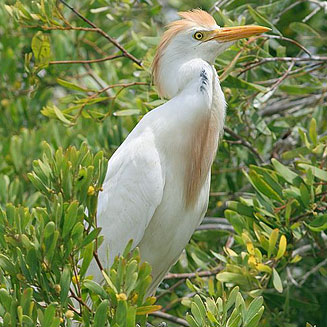 |
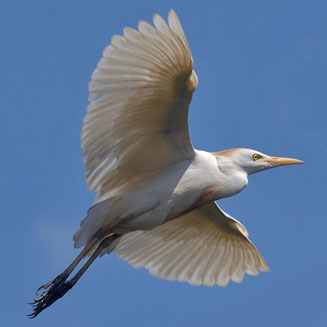 |
Cattle egret male in breeding
plumage, Robben Island, South Africa
. [photo Trevor
Hardaker ©] |
Cattle egret male in breeding plumage. [photo
Callie de Wet ©] |
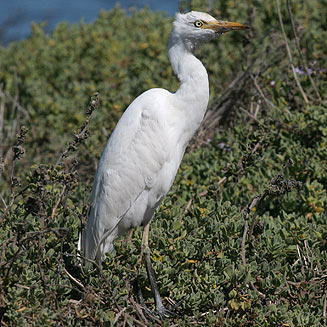 |
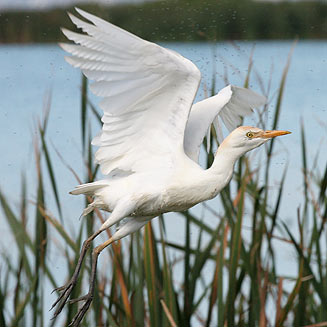 |
| Cattle Egret, Strandfontein Sewrage
Works, Western Cape, South Africa. [photo
Duncan Robertson ©] |
Cattle Egret, Strandfontein Sewrage Works,
Western Cape, South Africa. [photo
Duncan Robertson ©] |
Distribution and habitat
Historically confined to Asia and
tropical Africa, but since the late 19th Century it has spread across the world,
to southern Europe, north-eastern South America, Australia, New Zealand
and sub-Saharan Africa. It is very common across most of southern Africa, while
more scarce in the arid parts of Namibia, Botswana and the Northern Cape. It
generally prefers open grassland, grassy savanna, man-made fields and
agricultural land, occasionally moving to the seashore.
|
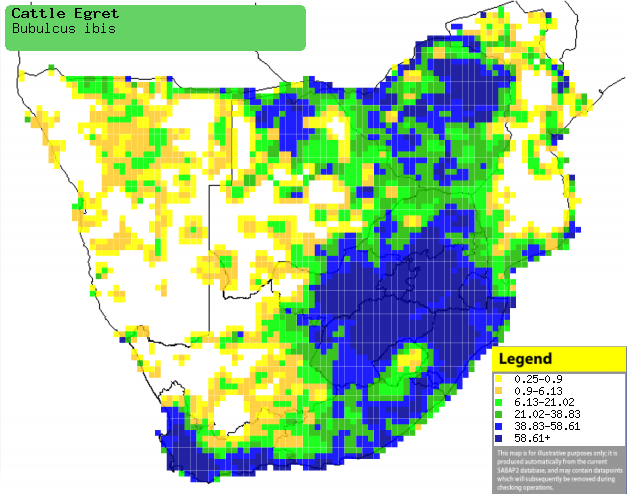 |
|
Distribution of Cattle egret in
southern Africa, based on statistical smoothing of the
records from first SA Bird Atlas Project (©
Animal Demography unit,
University of Cape Town; smoothing by Birgit Erni and
Francesca Little). Colours range from dark blue (most
common) through to yellow (least common).
See here for the latest
distribution from the SABAP2. |
Predators and parasites
- Predators
- of adults
- of eggs and nestlings
Movements and migrations
Generally resident in southern Africa, however
it can be locally nomadic, moving in response to rainfall and sometimes
dispersing over large distances.
Food
It mainly eats insects, doing most of its foraging by
walking on the ground, chasing down and stabbing its prey. As its name suggests,
it also associates with livestock and other large mammals, perching on their
backs to glean ectoparasites and hawk insects that the mammal disturbs
when moving around. The following food items have been recorded in its diet:
- Invertebrates
- insects
- arachnids
- ticks
- Boophilus decoratus (Blue ticks)
- Amblyomma hebraeum (Bont ticks)
- worms
- molluscs
- Vertebrates
- amphibians
- Rana (frogs)
- Xenopus laevis (Common platanna)
- Bufo regularis (Common toad)
- tadpoles
- fish
- reptiles
- small mammals
- birds
Breeding
- Monogamous, colonial nester, breeding in colonies of up to about 10 000
nests. Other waterbird species are often present in these colonies, although
they are always greatly outnumbered by Cattle egrets.
- The nest is built solely by the female with material delivered by the
male, consisting of an untidy platform of dry sticks, reeds and weed stems,
sometimes lined with grass. It is typically placed in a tree or reedbed over
water, often close to touching the nests of other Cattle egrets.
- Egg-laying season is from June-July in Namibia, but from August-April
elsewhere in southern Africa, peaking from September-December.
- It lays 1-7 eggs, which are incubated by both sexes for about 22-26
days.
- The chicks are fed and brooded by both parents, who defend them closely
for the first 10 days of their lives. They leave the nest at roughly 20 days
old, learning to fly at 30 days old and becoming fully independent about 15
days later.
Threats
Not threatened.
References
-
Hockey PAR, Dean WRJ and Ryan PG 2005. Roberts - Birds of
southern Africa, VIIth ed. The Trustees of the John Voelcker Bird Book
Fund, Cape Town.
|
